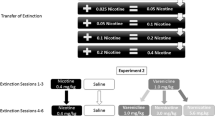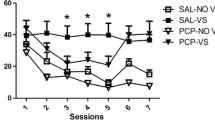Abstract
Rationale
Discrete cues, such as drug-associated paraphernalia, play an important role in tobacco smoking and relapse, an effect that can be modelled in the nicotine-seeking behaviour of laboratory animals. However, the role of contextual stimuli (i.e. the drug taking environment) within nicotine dependence is less clear. The present study investigated the effects of contextual stimuli on nicotine detoxification and relapse.
Materials and methods
Male hooded Lister rats were trained to self-administer nicotine (0.03 mg/kg/infusion) in one of two distinct environmental contexts: transparent walls and rod floor or checkerboard walls and grid floor. Extinction of drug-seeking behaviour, either in the acquisition context or alternate context, was achieved by removing both nicotine infusions and response-contingent cues. The two contexts were then presented with or without nicotine priming and response-contingent cue presentation.
Results
The initial rate of extinction was quicker in a novel environment compared to in the same context as training, although similar low levels of responding were eventually reached. Nicotine priming and re-presentation of cues resulted in significant reinstatement of nicotine-seeking behaviour, but there was a trend towards a reduction in this effect when conducted in a novel environment. In addition, re-presentation of the acquisition context after extinction in the alternate context produced a significant reinstatement of nicotine-seeking behaviour without the need for nicotine priming and re-presentation of cues.
Conclusions
Contextual stimuli are capable of modulating the extinction and reinstatement of nicotine-seeking behaviour, and exposure to environments previously associated with smoking may lead to an increased risk of relapse. Context is an additional factor that could be targeted when developing smoking cessation strategies. For example, the long-term success of cue exposure might be improved by conducting treatment in multiple settings.




Similar content being viewed by others
References
Anthony JC, Warner LA, Kessler RC (1994) Comparative epidemiology of dependence on tobacco, alcohol, controlled substances, and inhalants: basic findings from the national comorbidity survey. Exp Clin Psychopharm 2:244–268
Arroyo M, Markou A, Robbins TW, Everitt BJ (1998) Acquisition, maintenance and reinstatement of intravenous cocaine self-administration under a second-order schedule of reinforcement in rats: effects of conditioned cues and continuous access to cocaine. Psychopharmacology 140:331–344
Baldinger B, Hasenfratz M, Battig K (1995) Switching to ultralow nicotine cigarettes: effects of different tar yields and blocking of olfactory cues. Pharm Biochem Behav 50:233–239
Bossert JM, Liu SY, Lu L, Shaham Y (2004) A role of ventral tegmental area glutamate in contextual cue-induced relapse to heroin seeking. J Neurosci 24:10726–10730
Bossert JM, Poles GC, Wihbey KA, Koya E, Shaham Y (2007) Differential effects of blockade of dopamine D1-family receptors in nucleus accumbens core or shell on reinstatement of heroin seeking induced by contextual and discrete cues. J Neurosci 27:12655–12663
Bouton ME (1993) Context, time, and memory retrieval in the interference paradigms of Pavlovian learning. Psychol Bull 114:80–99
Bouton ME (2004) Context and behavioral processes in extinction. Learn Mem 11:485–494
Bouton ME, Bolles RC (1979) Role of conditioned contextual stimuli in reinstatement of extinguished fear. J Exp Psychol: Animal Behav Proc 5:368–378
Bouton ME, Ricker ST (1994) Renewal of extinguished responding in a second context. Animal Learn Behav 22:317–324
Brauer LH, Behm FM, Lane JD, Westman EC, Perkins C, Rose JE (2001) Individual differences in smoking reward from de-nicotinized cigarettes. Nicotine Tobacco Res 3:101–109
Burattini C, Gill TM, Aicardi G, Janak PH (2006) The ethanol self-administration context as a reinstatement cue: acute effects of naltrexone. Neuroscience 139:877–887
Butschky MF, Bailey D, Henningfield JE, Pickworth WB (1995) Smoking without nicotine delivery decreases withdrawal in 12-hour abstinent smokers. Pharm Biochem Behav 50:91–96
Caggiula AR, Donny EC, White AR, Chaudhri N, Booth S, Gharib MA, Hoffman A, Perkins KA, Sved AF (2001) Cue dependency of nicotine self-administration and smoking. Pharm Biochem Behav 70:515–530
Caggiula AR, Donny EC, Chaudhri N, Perkins KA, Evans-Martin FF, Sved AF (2002a) Importance of nonpharmacological factors in nicotine self-administration. Physiol Behav 77:683–687
Caggiula AR, Donny EC, White AR, Chaudhri N, Booth S, Gharib MA, Hoffman A, Perkins KA, Sved AF (2002b) Environmental stimuli promote the acquisition of nicotine self-administration in rats. Psychopharmacology 163:230–237
Cohen C, Perrault G, Voltz C, Steinberg R, Soubrie P (2002) SR141716, a central cannabinoid (CB(1)) receptor antagonist, blocks the motivational and dopamine-releasing effects of nicotine in rats. Behav Pharmacol 13:451–463
Conklin CA (2006) Environments as cues to smoke: implications for human extinction-based research and treatment. Exp Clin Psychopharm 14:12–19
Conklin CA, Tiffany ST (2002) Applying extinction research and theory to cue-exposure addiction treatments.[see comment]. Addiction 97:155–167
Corrigall WA, Coen KM (1989) Fixed-interval schedules for drug self-administration in the rat. Psychopharmacology 99:136–139
Corrigall WA, Franklin KB, Coen KM, Clarke PB (1992) The mesolimbic dopaminergic system is implicated in the reinforcing effects of nicotine. Psychopharmacology 107:285–289
Crombag HS, Badiani A, Maren S, Robinson TE (2000) The role of contextual versus discrete drug-associated cues in promoting the induction of psychomotor sensitization to intravenous amphetamine. Behav Brain Res 116:1–22
Crombag HS, Grimm JW, Shaham Y (2002) Effect of dopamine receptor antagonists on renewal of cocaine seeking by reexposure to drug-associated contextual cues. Neuropsychopharmacology 27:1006–1015
Crombag HS, Shaham Y (2002) Renewal of drug seeking by contextual cues after prolonged extinction in rats. Behav Neurosci 116:169–173
Donny EC, Caggiula AR, Knopf S, Brown C (1995) Nicotine self-administration in rats. Psychopharmacology 122:390–394
Donny EC, Caggiula AR, Mielke MM, Booth S, Gharib MA, Hoffman A, Maldovan V, Shupenko C, McCallum SE (1999) Nicotine self-administration in rats on a progressive ratio schedule of reinforcement. Psychopharmacology 147:135–142
Donny EC, Caggiula AR, Rowell PP, Gharib MA, Maldovan V, Booth S, Mielke MM, Hoffman A, McCallum S (2000) Nicotine self-administration in rats: estrous cycle effects, sex differences and nicotinic receptor binding. Psychopharmacology 151:392–405
Donny EC, Chaudhri N, Caggiula AR, Evans-Martin FF, Booth S, Gharib MA, Clements LA, Sved AF (2003) Operant responding for a visual reinforcer in rats is enhanced by noncontingent nicotine: implications for nicotine self-administration and reinforcement [see comment]. Psychopharmacology 169:68–76
Epstein DH, Preston KL, Stewart J, Shaham Y (2006) Toward a model of drug relapse: an assessment of the validity of the reinstatement procedure. Psychopharmacology 189:1–16
Fuchs RA, Evans KA, Ledford CC, Parker MP, Case JM, Mehta RH, See RE (2005) The role of the dorsomedial prefrontal cortex, basolateral amygdala, and dorsal hippocampus in contextual reinstatement of cocaine seeking in rats. Neuropsychopharmacology 30:296–309
Goldberg SR, Gardner ML (1981) Second-order schedules: extended sequences of behavior controlled by brief environmental stimuli associated with drug self-administration. NIDA Res Monograph 37:241–270
Goldberg SR, Spealman RD, Goldberg DM (1981) Persistent behavior at high rates maintained by intravenous self-administration of nicotine. Science 214:573–575
Gross J, Lee J, Stitzer ML (1997) Nicotine-containing versus de-nicotinized cigarettes: effects on craving and withdrawal. Pharm Biochem Behav 57:159–165
Gunther LM, Denniston JC, Miller RR (1998) Conducting exposure treatment in multiple contexts can prevent relapse. Behav Res Therapy 36:75–91
Kelamangalath L, Swant J, Stramiello M, Wagner JJ (2007) The effects of extinction training in reducing the reinstatement of drug-seeking behavior: involvement of NMDA receptors. Behav Brain Res 185:119–128
Lazev AB, Herzog TA, Brandon TH (1999) Classical conditions of environmental cues to cigarette smoking. Exp Clin Psychopharm 7:56–63
Le Foll B, Goldberg SR (2005) Nicotine induces conditioned place preferences over a large range of doses in rats. Psychopharmacology 178:481–492
LeSage MG, Burroughs D, Dufek M, Keyler DE, Pentel PR (2004) Reinstatement of nicotine self-administration in rats by presentation of nicotine-paired stimuli, but not nicotine priming. Pharmacol Biochem Behav 79:507–513
Mackintosh NJ (1974) The psychology of animal learning. Academic, London
Markou A, Weiss F, Gold LH, Caine SB, Schulteis G, Koob GF (1993) Animal models of drug craving. Psychopharmacology 112:163–182
Mucha RF, Pauli P, Angrilli A (1998) Conditioned responses elicited by experimentally produced cues for smoking. Can J Physiol Pharm 76:259–268
O’Brien CP, Childress AR, McLellan AT, Ehrman R (1992) Classical conditioning in drug-dependent humans. Ann NY Acad Sci 654:400–415
O’Brien CP, Childress AR, Ehrman R, Robbins SJ (1998) Conditioning factors in drug abuse: can they explain compulsion? J Psychopharm 12:15–22
Olausson P, Jentsch JD, Taylor JR (2004) Nicotine enhances responding with conditioned reinforcement. Psychopharmacology 171:173–178
Pavlov PA (1927) Conditioned reflexes: an investigation of the physiological activity of the cerebral cortex. Oxford Univ. Press, London
Perkins KA, Grobe JE, Fonte C, Goettler J, Caggiula AR, Reynolds WA, Stiller RL, Scierka A, Jacob RG (1994) Chronic and acute tolerance to subjective, behavioral and cardiovascular effects of nicotine in humans. J Pharm Exp Ther 270:628–638
Perkins KA, Gerlach D, Vender J, Grobe J, Meeker J, Hutchison S (2001) Sex differences in the subjective and reinforcing effects of visual and olfactory cigarette smoke stimuli. Nicotine Tobacco Res 3:141–150
Robbins S (1990) Mechanisms underlying spontaneous recovery in autoshaping. J Exp Psychol Anim Behav Proc 16:235–249
Robinson TE, Browman KE, Crombag HS, Badiani A (1998) Modulation of the induction or expression of psychostimulant sensitization by the circumstances surrounding drug administration. Neurosci Biobehav Rev 22:347–354
Rose JE, Levin ED (1991) Inter-relationships between conditioned and primary reinforcement in the maintenance of cigarette smoking. Br J Addiction 86:605–609
Rose JE, Corrigall WA (1997) Nicotine self-administration in animals and humans: similarities and differences. Psychopharmacology 130:28–40
Rose JE, Tashkin DP, Ertle A, Zinser MC, Lafer R (1985) Sensory blockade of smoking satisfaction. Pharm Biochem Behav 23:289–293
Rose JE, Behm FM, Westman EC, Johnson M (2000) Dissociating nicotine and nonnicotine components of cigarette smoking. Pharmacol Biochem Behav 67:71–81
Schenk S, Partridge B (2001) Influence of a conditioned light stimulus on cocaine self-administration in rats. Psychopharmacology 154:390–396
See RE, Grimm JW, Kruzich PJ, Rustay N (1999) The importance of a compound stimulus in conditioned drug-seeking behavior following one week of extinction from self-administered cocaine in rats. Drug Alcohol Depend 57:41–49
Shaham Y, Adamson LK, Grocki S, Corrigall WA (1997) Reinstatement and spontaneous recovery of nicotine seeking in rats. Psychopharmacology 130:396–403, erratum appears in Psychopharmacology (Berl) 1997 Sep;133(1):106
Shaham Y, Shalev U, Lu L, De Wit H, Stewart J (2003) The reinstatement model of drug relapse: history, methodology and major findings [see comment]. Psychopharmacology 168:3–20
Shoaib M (2006) Effects of isoarecolone, a nicotinic receptor agonist in rodent models of nicotine dependence. Psychopharmacology 188:252–257
Shoaib M, Schindler CW, Goldberg SR (1997) Nicotine self-administration in rats: strain and nicotine pre-exposure effects on acquisition. Psychopharmacology 129:35–43
Shoaib M, Sidhpura N, Shafait S (2003) Investigating the actions of bupropion on dependence-related effects of nicotine in rats. Psychopharmacology 165:405–412
Spealman RD, Barrett-Larimore RL, Rowlett JK, Platt DM, Khroyan TV (1999) Pharmacological and environmental determinants of relapse to cocaine-seeking behavior. Pharmacol Biochem Behav 64:327–336
Acknowledgement
We thank the University of Newcastle and Merck, Sharp and Dohme for supporting this research.
Author information
Authors and Affiliations
Corresponding author
Rights and permissions
About this article
Cite this article
Wing, V.C., Shoaib, M. Contextual stimuli modulate extinction and reinstatement in rodents self-administering intravenous nicotine. Psychopharmacology 200, 357–365 (2008). https://doi.org/10.1007/s00213-008-1211-y
Received:
Accepted:
Published:
Issue Date:
DOI: https://doi.org/10.1007/s00213-008-1211-y




